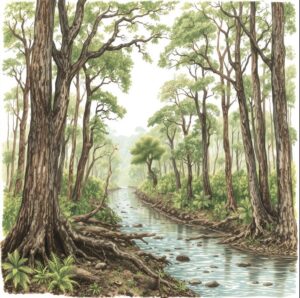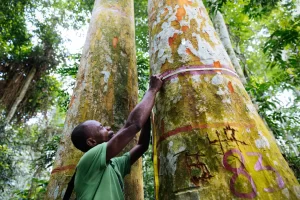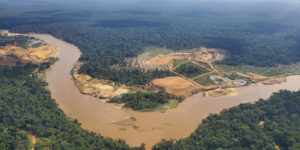By Editorial Staff
A treasure of unparalleled ecological and global significance lies in the heart of Africa—the Congo Basin, a sprawling green expanse often dubbed the “lungs and beating heart of the planet.” This natural marvel, home to some of the Earth’s richest biodiversity and a lifeline for millions of people, suffers an onslaught of threats: rampant deforestation, unsustainable agriculture, and the looming specter of climate change.
Yet, amidst these challenges, a symphony of hope emerges through groundbreaking initiatives like the Central African Forest Initiative (CAFI) and the Natural Capital Project. These bold projects, rooted in sustainability and innovation, are not just preserving this irreplaceable ecosystem; they are forging a global blueprint for harmony between nature and humanity. This article is situated in the context of Life In Humanity‘s reporting project— “Echoes of the Earth: From the Congo Basin to the Amazon”— exploring the vital role of these forests in protecting global ecosystems, ensuring the stability of climate in the world, sustaining local communities, and emphasizing upon the crucial need for urgent action to safeguard these forests.
In this regard, the following list provides articles already published about this basin:
- “Rwanda’s stake in the Congo Basin’s future —a global perspective” accessible here.
- “The heart of Africa’s climate: understanding the Congo Basin”you can reach here.
- “The Congo Basin under siege: mounting threats to the world’s second-largest rainforest” accessible here.
- The Congo Basin under siege: unmasking the hidden drivers fueling its crisis, part I accessible here.
- The Congo Basin under siege: unmasking the hidden drivers fueling its crisis, part II which you can access here.
- Turning the tide of the Congo Basin’s threats: strategies to preserve the heart of the whole planet, accessible here.
More details on the Central African Forest Initiative (CAFI)
This initiative’s objective is to combat deforestation and degradation while promoting sustainable livelihoods in Congo Basin countries. CAFI works with governments to implement sustainable land-use planning, address agricultural expansion, ensure forest conservation, and promote clean energy alternatives. The initiative fosters public-private partnerships to leverage funding and technical support for forest conservation and reforestation projects.
CAFI has mobilized significant funding for governance reforms, sustainable agriculture, and renewable energy projects. The partnership initiative gathers a coalition of donors, six partner countries being covered by the Congo Basin, and a huge number of implementing organizations.
The donors include Belgium, the European Union, France, Germany, the Netherlands, Norway, the Republic of Korea, Sweden, the United Kingdom and the United States. The partner countries are the Central African Republic, the Democratic Republic of the Congo (DRC), the Republic of Cameroon, the Republic of Congo, the Republic of Equatorial Guinea, and the Republic of Gabon.
The implementing organizations involve the Belgian Development Agency (ENABEL), Farm Africa, One Acre Fund , the Food and Agriculture Organization (FAO), the French Development Agency (AFD),the German Agency for International Cooperation (GIZ), International Union for Conservation of Nature (IUCN), the Japan International Cooperation Agency (JICA), the Nature Conservancy, the United Nations Educational, Scientific and Cultural Organization (UNESCO), the United Nations Capital Development Fund (UNCDF) , the United Nations Development Programme (UNDP), the United Nations Settlements Programme (UN-Habitat), the United Nations Population Fund (UNFPA), the United Nations Office for Project Services (UNOPS), and the World Bank.
CAFI forms both a trust fund supporting direct investments on the ground and a political negotiation platform aiming to catalyze a high-level policy dialogue. According to its website, CAFI was established in 2015 at the margins of the United Nations General Assembly. Climate Funds Update specifies that that this fund will function until December 2027.
Achievements of the CAFI

Though Life In Humanity has not been able to find any document thoroughly elucidating accomplishments attained so far, it is convinced that the initiative has already furnished a considerable contribution to the protection of the basin. An amount already provided for the fund and some major highlights can also serve as a testament.
To be more enlightened on the fund’s impact, we are going to avail ourselves of its piece of writing entitled “CAFI 2022 Highlights.” Its key highlights include the following details. 843 million US$ had been committed to CAFI, with 406 million transferred to implementing organizations. 42 projects had been funded, with 36 active and 6 closed ones. 6.5 million beneficiaries had been reached, including 33,000 households with increased food security. High level policy dialogues with more than 30 ministries had been conducted.
The following details pertain to some of key 2022 results per country, according to the piece.
DRC
The total number of hectares under local management plans in the DRC reached 8.5 million hectares (1/4 the size of the United Kingdom). A detailed programmatic framework in the DRC had been agreed upon, aiming to achieve the objectives of the 500 million US$ of the 2021-2026 Letter of Intent, and a Call for Expressions of Interest had been launched.
195,621 hectares of local community forestry concessions were established with titles in 2022 alone, bringing the total to 361,045 hectares or 43,5 % of the current portfolio target. The total number of rural direct beneficiaries in the DRC was then an estimated 66,5000 in 9 provinces, while indirect beneficiaries were estimated between 3 and 6.5 million.
The implications of a forest covering a certain number of hectares being placed under local management plans stand vast and multifaceted, spanning ecological, social, and economic dimensions.

For instance, local management often focuses on sustainable practices; which helps to preserve biodiversity by protecting habitats and preventing overexploitation. Local management plans often involve community participation; which enhances local governance and empowers indigenous or rural communities. Programs and involvement in forest management under the plans increase awareness and knowledge about sustainable practices. Local management creates jobs and sustains livelihoods through eco-tourism, non-timber forest products, and sustainable logging.
The fact that the 195,621 hectares of forest land were officially designated as community forestry concessions means that they were handed over to local communities for management, with legal titles formalizing their rights and responsibilities. Designating forests as community forestry concessions does not inherently lead to their destruction, but it does come with risks that require careful management. Community forestry concessions are typically governed by specific rules and regulations to ensure sustainable use, but the success of these measures depends on the framework and its enforcement.
To avert any potential risks, certain mechanisms are carried out, the following being some of them. Community forestry concessions usually come with legally binding agreements that outline sustainable practices, prohibit destruction, and set penalties for violations. Governments, non-governmental organizations or other bodies provide training and resources (capacity-building) to help communities manage forests sustainably, including agroforestry, reforestation, and low-impact logging techniques. Regular monitoring by local authorities or independent bodies ensures compliance with sustainable practices and identifies problems early.
In several parts of the world, community-managed forests have been shown to outperform state-managed or privately-owned forests in terms of conservation and sustainable use. Some examples include Nepal and Mexico. In Nepal, community forestry programs have resulted in significant reforestation and biodiversity preservation. In Mexico, community forestry enterprises generate sustainable income while maintaining forest cover.
Cameroon and Gabon
In Gabon, the first 5 projects approved under the first historic Gabon results-based payment agreement were launched. The phrase “the first historic Gabon results-based payment agreement” signifies agreement under which the country has received payment for achieving measurable results.
In Cameroon, firm progress had been accomplished in the partnership with Cameroon, with a launch of the first Calls for Expressions of Interest worth 60 million US$ which were planned for 2023. Initial projects included intersectoral coordination, a focus on the Grand Mbam landscape, payments for environmental services in the coffee and cocoa sectors, and capacity-building.
The Natural Capital Project

Centered at Stanford University, the Natural Capital Project represents a partnership among World Wildlife Fund (WWF), Stanford, University of Minnesota, The Nature Conservancy, Chinese Academy of Sciences, and Stockholm Resilience Centre. WWF says “Through pioneering science, cutting-edge technology, and collaborative partnerships worldwide, the Natural Capital Project works to integrate the value nature provides to people into all major decisions.
The child project of the Congo Basin Sustainable Landscapes Impact Program (CBSL IP) aims to strengthen the integrated management of Cameroon’s globally important forest landscapes in the Congo Basin to secure its biological integrity and increase economic opportunities and livelihoods for forest dependent people.”
The protection of the Congo Basin demands a monumental effort that transcends national borders, recognizing that its future hinges on the collaboration of six countries directly invested in its fate. The project assures that it forges alliances and builds bridges. WWF explains “Ensuring protection of the Congo Basin requires a massive effort that reaches beyond political borders, especially when six countries have a direct stake. As part of the Congo Basin Forest Partnership, we collaborate with local governments and communities to sustainably manage the forests and protect wildlife.
We help create agreements between governments to allow for free movement of park staff across borders and joint patrols, bolstering antipoaching operations. Our partnerships also allow us to better address the needs of local communities that depend on the forests, empowering them to steward their resources and improve their livelihoods. Poaching continues to be a growing problem in the Congo Basin, even within national parks and other protected areas. We also see the need to improve people’s standards of living in order to reduce their dependence on nature.”
Towards a resilient future for the Congo Basin: building on success

The efforts underway in the Congo Basin, driven by initiatives like CAFI and supported by international partnerships, have laid a solid foundation for preserving the world’s second-largest tropical forest. However, the battle to protect this vital ecosystem is far from over. The challenges posed by deforestation, climate change, and socio-economic pressures are ever-evolving, demanding adaptive strategies and continuous commitment from all stakeholders involved.
Looking ahead, the key to safeguarding the Congo Basin’s future lies in strengthening the collaboration among governments, local communities, international donors, and conservation organizations. The integration of sustainable development goals with forest conservation practices will be essential at achieving a balance between ecological preservation and socio-economic development. Furthermore, enhanced funding, robust policy frameworks, and the use of innovative technologies to monitor and manage the basin’s resources can play a crucial role in scaling up the impact of current efforts.
For communities in the Congo Basin, the success of these initiatives offers a unique opportunity to not only protect their natural heritage but also to thrive through sustainable livelihoods. Local management of forests, alongside incentives for conservation, holds the potential to create lasting, positive change for millions of people who depend on these ecosystems for their survival.
As the global community continues to face the urgent threat of climate change, the Congo Basin stands as a critical piece of the puzzle. The lessons learned from initiatives like CAFI offer a blueprint for other regions facing similar challenges. The future of the Congo Basin and the planet’s well-being are intertwined, and it is through collective action and a commitment to sustainability that this invaluable resource will endure for generations to come.